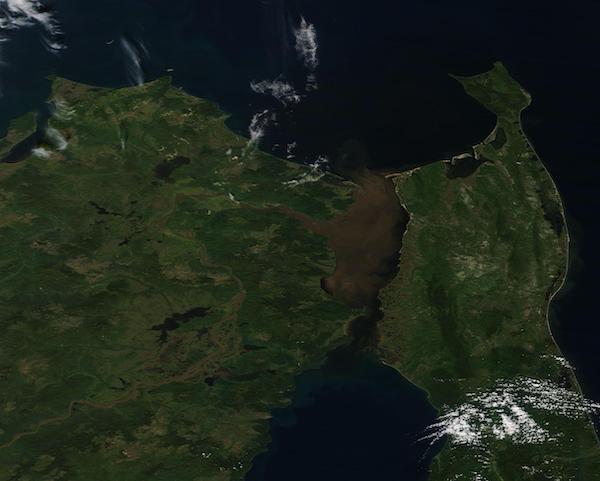Images
September 16, 2020 - Sediment in the Strait of Tartary
Tweet
Swirls of brown sediment stained the blue waters of the Strait of Tartary in mid-September 2020. The Moderate Resolution Imaging Spectroradiometer (MODIS) on board NASA’s Terra satellite acquired a true-color image of the scene on September 12.
The Strait of Tartary (Tartar Strait) sits between the eastern Russian mainland and Sakhalin Island, connecting the Sea of Okhotsk (north) from the Sea of Japan (south). At the narrowest point, the Strait is a mere 4.5 mi (7 km) wide but it still provides an important shipping lane and in the wider stretches, harbors several important Russian seaports. It is typically clogged with ice between mid-November and mid-May.
The Strait receives fresh water from the Amur River, the world’s tenth-longest river. The Amur rises in Mongolia, then flows east along the Chinese-Russian border before turning northeast and ultimately emptying into the Strait of Tartary. As it passes mountains, steppe, agricultural land, and towns, the Amur collects sediment. When the flow of the river is strong, the sediment can be carried thousands of miles only to be spilled into the Strait of Tartary. According to a study published in Marine Physics in 2017, the spreading of the sediment plume into the Strait of Tartary typically takes place only during the Amur’s freshet periods (times of high water flows, typically during ice melt), and when there is strong western wind forcing, which induces southward transport. The study states, “The average duration of this process during the ice-free season is estimated as 15 days; however, in individual years, it can be as short as several days”.
Image Facts
Satellite:
Terra
Date Acquired: 9/12/2020
Resolutions:
1km (46.7 KB), 500m (161.7 KB), 250m (477.5 KB)
Bands Used: 1,4,3
Image Credit:
MODIS Land Rapid Response Team, NASA GSFC
Tweet
Swirls of brown sediment stained the blue waters of the Strait of Tartary in mid-September 2020. The Moderate Resolution Imaging Spectroradiometer (MODIS) on board NASA’s Terra satellite acquired a true-color image of the scene on September 12.
The Strait of Tartary (Tartar Strait) sits between the eastern Russian mainland and Sakhalin Island, connecting the Sea of Okhotsk (north) from the Sea of Japan (south). At the narrowest point, the Strait is a mere 4.5 mi (7 km) wide but it still provides an important shipping lane and in the wider stretches, harbors several important Russian seaports. It is typically clogged with ice between mid-November and mid-May.
The Strait receives fresh water from the Amur River, the world’s tenth-longest river. The Amur rises in Mongolia, then flows east along the Chinese-Russian border before turning northeast and ultimately emptying into the Strait of Tartary. As it passes mountains, steppe, agricultural land, and towns, the Amur collects sediment. When the flow of the river is strong, the sediment can be carried thousands of miles only to be spilled into the Strait of Tartary. According to a study published in Marine Physics in 2017, the spreading of the sediment plume into the Strait of Tartary typically takes place only during the Amur’s freshet periods (times of high water flows, typically during ice melt), and when there is strong western wind forcing, which induces southward transport. The study states, “The average duration of this process during the ice-free season is estimated as 15 days; however, in individual years, it can be as short as several days”.
Image Facts
Satellite:
Terra
Date Acquired: 9/12/2020
Resolutions:
1km (46.7 KB), 500m (161.7 KB), 250m (477.5 KB)
Bands Used: 1,4,3
Image Credit:
MODIS Land Rapid Response Team, NASA GSFC




